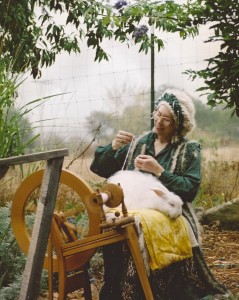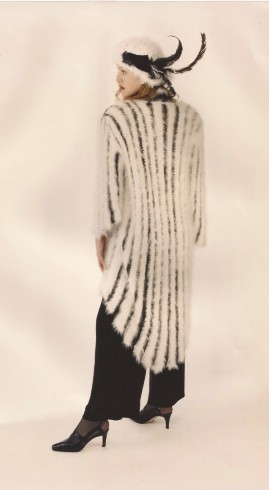I first heard about Angora rabbits in my first spinning class in 1977. Lydia Van Gelder, our instructor, told us about all sorts of fiber sources and mentioned that an Angora rabbit could even be placed on our laps and plucked and spun directly from the lap into the wheel. This intrigued me and later I followed up (once I got better at spinning) and tried it myself at a friend’s house. The Angora rabbits were cuddly and, although not used to me, were friendly and calmed down quickly once I began spinning which seems to settle them down. That was my introduction into the world of Angora.
Angora rabbits originated in Turkey, hence the name (a derivation of Ankara, the capital city). There is also an Angora cat and an Angora Goat (our source for mohair). These rabbits became pets of French royalty in the mid 18th century, and eventually spread to the rest of Europe. They have been bred for their long hair which can be plucked or shorn every 8-12 weeks, or combed. I have always preferred to pluck, as I love the meditation and close interaction of that process. There are 4 main breeds of Angora recognized by the American Rabbit Breeders Association—English (the only one with hair covering his eyes and on the tips of the ears, French (my favorite ), Giant, (large and very big producer which must generally be shorn) and Satin, ( a breed that is a cross between a short hair satin and a French Angora. I have also come across Jersey Woolies but they are not as yet recognized as a breed.
I love the silky, fine and very soft hair they produce. I love the warmth it creates and most of all I love the halo effect that just grows and grows with petting. Angora is also one of the many somewhat exotic fibers that are warmer than wool.
The Angora rabbits have a wonderful temperament. They have been bred for hundreds of years and therefore are accustomed to people. They are curious and will hop all over the floor if allowed. They like lap time and love to be brushed and definitely love the massage that plucking them provides at moulting time.
The hair growth, however, can also create a health problem, if the caregiver doesn’t keep track of the growth. If the hair isn’t removed in a timely fashion (8-12 weeks for plucking or shearing or a continuous brushing program), the hair will either begin to matt on the rabbit or the rabbit will try to take it off for himself and end up with wool block. This can be a serious problem if not treated promptly.
Angora rabbits can live 5-7 years under good conditions. The primary care is to give them an ample amount of cage space, lots of good hay (I prefer alfalfa) and to occasionally feed a bromelin source such as pineapple and a papain source such as papaya. The most important concern is to be on top of the hair production and prevent wool block. Once that is taken care of, the rest is simple daily care.
The pleasure for me is the plucking process. Luckily it is also the pleasure part for the rabbit. Sitting the rabbit on my lap (usually on a folded towel ) and then carefully plucking a finger pinch of hair and spinning it is a meditative process for us both. It generally puts the rabbit to sleep on my lap and is a peaceful time for me. I can generally pluck one of my rabbits in an hour. The plucking process is simply a matter of taking a pinch of the hair that comes out at moulting time with my thumb and fore finger and since the wheel is right there I simply pluck and spin, (extra twist) and then pluck and spin again. Angora requires extra twist as there are no scales like wool. The rabbit can sometimes appear quite nude when I am through if it is summer or not so nude if it is winter, depending on how much hair I want to leave on and what stage of the regrowth process the rabbit is in.
Now all of this is simply to get my hands on some wonderful Angora yarn and turn it into a spectacular garment. I love creating soft and fuzzy wraps and I love being “petted” when I wear them. This wonderful “Fur without Guilt” has been my inspiration for years and has given me much pleasure. It has led me into becoming a fiber artist / fashion designer and taken me into classrooms and care homes for demonstrations, Festivals, Fashions Shows and Harvest Fairs and even gave me my first National Award as a Niche Winner at the Rosen Show in Philadelphia and in the Olympics last year. I now supply 9 boutiques across North America and enter several Wearable Art shows a year. And it’s all because I fell in love with a curious and cuddly rabbit with soft and wonderful long hair. It became my world of Angora.
For a change of pace and texture, Click here.

